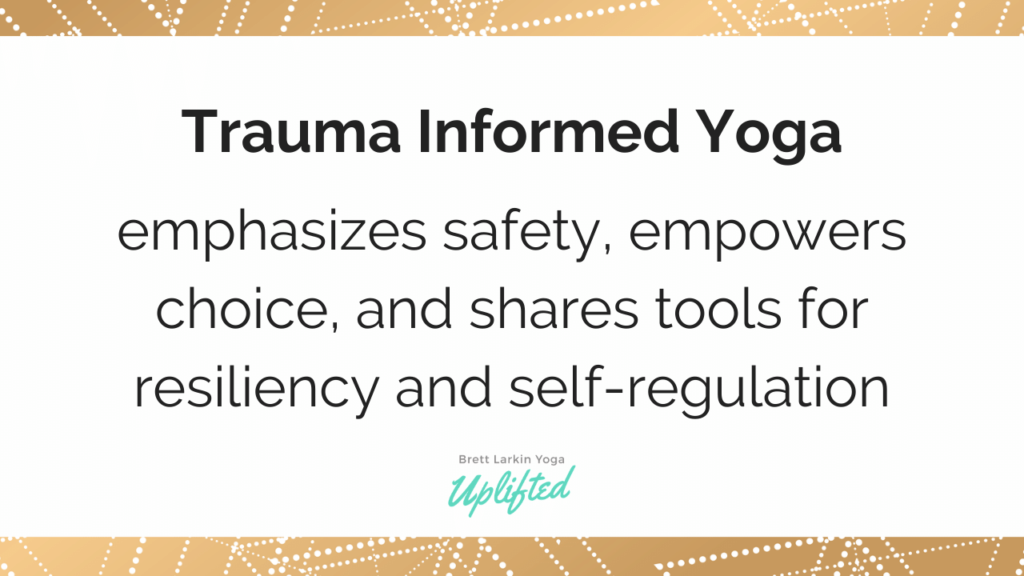
While most of us in the yoga community have heard of “trauma informed yoga”, I find many are unclear about what a trauma informed yoga practice actually is, how to train in this type of yoga, and whether there’s evidence to support it.
So I’d love to shed some light on this subject as I am passionate about spreading knowledge on significant yoga topics so that teachers can make the best, most informed decisions for themselves and their students.
What is Trauma Informed Yoga?
Also called “trauma sensitive yoga”, it is a therapeutic application of yoga that is designed to be sensitive to the needs of participants with trauma symptoms.
The intention of trauma sensitive yoga is to create a safe, welcoming, inclusive, and supportive space where students can start reconnecting with themselves and feel safe in their bodies. It emphasizes safety, empowers choice, and shares tools for resiliency and self-regulation.

Some ways that certified yoga instructors support these principles in a trauma informed class include:
- Teaching yoga poses that are accessible to everyone
- Avoiding vulnerable poses or overly activating asanas and breathing techniques
- Creating a calming, less stimulating atmosphere (lights might stay on)
- Guaranteeing no hands-on assists (the teacher may stay on their mat)
- Using languaging, sequencing, and yogic techniques that align with polyvagal theory and regulate the nervous system
- Using a tone of compassion and openness instead of rigid instruction, judgment, or pressure
- Prioritizing participant agency and choice in what they do with their body overachieving “correct” alignment
- Encouraging self-awareness, self-inquiry, and curiosity about one’s experience and physical sensations
- Teaching how to be present with what is, even if it’s unpleasant, over a “just focus on the positive” approach
- Teaching mindfulness and meditation for resiliency
- Assuming that all students have trauma in their past
While some of these components are common in traditional yoga classes, trauma specific training could be helpful to recognize trauma symptoms, learn what aspects of a standard yoga class are not conducive to healing trauma, and how to facilitate a supportive yoga experience for trauma survivors.
How Do I Get Trained For It?
Some 200-hour traditional yoga teacher training courses or 300-hour advanced yoga trainings include a module on trauma informed yoga, but many feel the most informed by taking a training specifically in trauma sensitive yoga.
There are typically two options for this type of training:
1. Take a full 200 or 300-hour trauma-informed yoga teacher training. These are less common, but there are a few out there. This could be a good option if you’re feeling called to specialize in working with trauma survivors.
2. Take a short course as an adjunct to your primary training. This is the more common option for certified yoga instructors who already hold a 200 or 500-hour certification. This type of program usually ranges from 10 hours completed over a weekend to 20 hours completed over the course of a week. Now there are even more options for this type of training as more online formats emerge that allow you to train from home.
Where to Get Your Trauma-Informed Yoga Certification
There are many trauma-sensitive yoga courses out there to choose from these days.
Look for those led by a yogi who is also a psychologist, psychotherapist, social worker, yoga therapist, or mental health provider that has experience implementing this style of yoga with trauma survivors and people with post-traumatic stress disorder (PTSD).
Yoga therapy schools are also a good place to look as the facilitators are generally experienced in the therapeutic application of yoga. Yoga therapy programs commonly offer trauma-informed yoga therapy modules that don’t require you to be enrolled in their full yoga therapy program or to be in yoga therapist training to attend.
Another great option for trauma-informed yoga training includes organizations that serve veteran and incarcerated populations. Often the curriculums have been honed and the lead trainers have many hours of putting the principles into practice. Even if you aren’t interested in teaching yoga to these populations, you could still benefit from their years of refining and practically applying their trauma-sensitive yoga program.
Who Are the Clients?
Trauma-informed yoga classes most commonly serve populations of veterans, inmates, those in treatment or rehabilitation centers, and women in shelters receiving domestic violence support.
These classes usually involve the teacher leading sessions in facilities where it is apparent that the clients may have trauma in their past. But it is important to note that outside of these contexts, it is not necessarily possible to identify a client with trauma.

Many think trauma comes from a singular traumatic event, but there is also developmental trauma and complex trauma that include exposure to many traumatic experiences over a period of time.
This means trauma and post-traumatic stress disorder can also come from emotional abuse, neglect, and the ways in which skin color, ethnicity, or cultural background can detrimentally impact a person’s relationship with their body, their community, and their sense of self as seen in the systemic patterns of trauma in marginalized groups.
While there may be some trauma symptoms you could identify as a yoga instructor, you likely won’t know which of your students is a trauma survivor.
So since a trauma survivor can look like you, me, or anyone at your local yoga studio, anyone is potentially a trauma-informed yoga client, which explains the tenet of trauma-informed yoga to teach as though everyone in class is a trauma survivor.
What Does the Research Say?
It’s more widely accepted now that yoga helps with things like anxiety and chronic stress, but is there evidence to support that trauma-sensitive yoga is effective in healing trauma or PTSD?
The short answer: The preliminary data looks promising, but more research is still needed.
There is a growing amount of evidence from preliminary studies (initial studies used to inform the validity or direction of further research) that supports the efficacy of trauma-informed yoga as a mental health intervention for trauma and PTSD.

Some of these findings include:
- One study with women with chronic, treatment-resistant PTSD showed that trauma-informed yoga significantly reduced PTSD symptoms compared with the control group (the group that received treatment other than trauma-informed yoga to be used for comparison).
- Another study found that Kundalini yoga done with a trauma-sensitive approach was correlated with significant changes in PTSD scores as well as positive results in measures of sleep, positive affect, perceived stress, anxiety, stress, and resilience.
- A review of multiple studies on trauma-informed yoga supported that there is tentative evidence to support the efficacy of trauma-sensitive yoga in reducing PTSD, depression, and anxiety symptomatology for women with PTSD and that this type of yoga could be a possible adjunctive mental health intervention.
- A small pilot study that used trauma-sensitive yoga as an intervention with military veterans showed a significant decrease in PTSD symptoms after the intervention. Participants also demonstrated improved mindfulness scores and decreased insomnia, depression, and anxiety symptoms. Further research with a control group would be important to substantiate these findings.
- This study on youth ages 12-21 in rehabilitation facilities shows qualitative evidence of trauma-sensitive yoga as a viable approach to increasing the self-regulatory capacity of traumatized youth, but more formalized study design in this area would be necessary to corroborate this.
Research that remains to be done includes longer term studies with more rigorous designs, larger sample sizes, diverse sample populations, and a direct comparison of traditional yoga with trauma-informed yoga. The preliminary results suggest the benefit of trauma-sensitive yoga, but more research could help add credibility to this relatively new practice.
Experience 3 Training Videos from Inside My 200-Hour Online YTT

YOU MIGHT ALSO LIKE
- What is Kriya Yoga? The Philosophy and Practice
- Uddiyana Bandha: Tapping Into Your Deep Core
- 4 Reasons Hasta Bandha Is Essential To Your Yoga Practice
- Vitarka Mudra: What It Is and How Do You Use It?
- Shakti Mudra: What It Is and How Do You Do It?
- Garuda Mudra: What It Is and How Do You Use It?
- Kali Mudra: What It Is and How Do You Do It?
- Shunya Mudra: What It Is and How Do You Do It?
- Varuna Mudra: What It Is and How Do You Use It?
- Vayu Mudra: What It Is and How Do You Use It?
- Samana Vayu: The Energy of Balance & How to Access It
- Apana Vayu: The Energy of Release & Surrender
- Udana Vayu: The Ascending Wind
- Prana Vayu: The Breath of Vitality
- Vyana Vayu: The Energetic Secret to Flow









